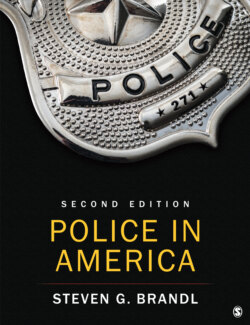Читать книгу Police in America - Steven G. Brandl - Страница 66
На сайте Литреса книга снята с продажи.
Then the 1960s Happened
ОглавлениеThroughout the 1950s, things were going smoothly for the police. By most accounts, crime was under control. The FBI reported that over 90% of homicides were solved by the police. Then things changed. Between 1960 and 1970, the crime rate doubled. It was the time of the civil rights movement and the related demonstrations, marches, and riots. The police found themselves on the front lines of the riots and demonstrations; often it was white officers facing off against African American citizens. It did not look good on television, in the newspapers, or in person. The predominantly white police forces became viewed by many as an “occupying army” in the low-income, minority ghettos of urban cities, and suddenly the police were viewed as racists and as “pigs.” American society was in turmoil. In 1963, President John F. Kennedy was assassinated. Later in the decade, senator and presidential candidate Robert Kennedy and civil rights leader Dr. Martin Luther King Jr. were murdered. Helter Skelter and Charles Manson were making headlines, and fear of crime increased dramatically. America was in the grip of the Vietnam War and the attendant protests against it. Drug use, the hippie movement, and women’s liberation were prominent counterculture movements. The Beatles sang “Revolution.”
Description
Figure 2.1 Representation of Minority Police Officers and Population in Select Cities, 1960s
These are estimates regarding the representation of minority officers in select police departments and the representation of minorities in those same cities late in the reform era. Minority officers were vastly underrepresented in police departments compared to their percentage of the general population.40
Source: Data from Advisory Commission on Civil Disorders. 1968. Report of the Advisory Commission on Civil Disorders. Washington, DC: National Criminal Justice Reference Service.
The police were experiencing a crisis, yet they were supposed to have the knowledge and capabilities to control crime successfully. If the situation was not bad enough for the police, the U.S. Supreme Court rendered several landmark decisions during this decade, such as Mapp v. Ohio and Miranda v. Arizona, that were seen as “handcuffing” the police. In 1967, the President’s Commission on Law Enforcement and the Administration of Justice issued a report that represented the first systematic analysis of crime and how the criminal justice system could be made more effective. Especially significant was its call for the incorporation of technology, data collection and analysis, and federal resources in crime fighting.
In the late 1960s and early 1970s, several major research studies were conducted to examine the effectiveness of police operations. It was found that motorized patrols did not prevent crime,41 detectives contributed little to solving crimes,42 and fast police responses to crime scenes seldom led to the police making on-scene apprehensions. Given the conditions of society, many people were not surprised by these conclusions. By the end of the 1960s, it was clear that the current style of policing was not working well. The police were once again in the midst of a crisis as they struggled to deal with the demands of the new society.
